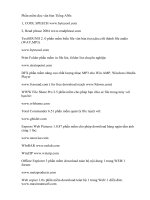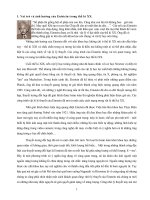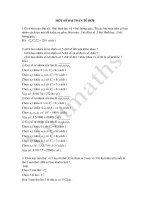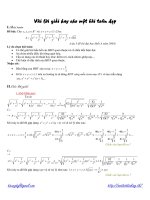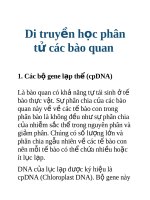Tài liệu đào tạo động cơ TDI 2.0 của Audi Volkswagan
Bạn đang xem bản rút gọn của tài liệu. Xem và tải ngay bản đầy đủ của tài liệu tại đây (1.86 MB, 44 trang )
Service Training
Self-study programme 316
The 2.0 ltr. TDI engine
Design and function
The days of sluggish and noisy diesel engines
that, when started, startled the whole neighbourhood out of bed and left a trail of black smoke
when full throttle was applied are long gone.
In order to meet the stricter emissions regulations
and to further reduce fuel consumption with
greater power output, Volkswagen uses the TDI
engine generation with 4 valve technology.
Driving performance, driving dynamics, driving
comfort, economy and emissions have been
markedly improved due to the consistent further
development of all the engine components, the
combustion procedure, the materials and
processes and also the injection pressures.
The 2.0 ltr. TDI engine was developed as the first
four cylinder diesel engine with four valve
technology in the Volkswagen Group for use in
the Touran, in the Golf 2004 and also in other
vehicles yet to be introduced.
S316_039
NEW
This self-study programme shows the design and
function of new developments!
The contents will not be updated.
2
For current inspection, adjustment and repair
instructions, please refer to the relevant service
literature.
Important
Note
Contents
Introduction . . . . . . . . . . . . . . . . . . . . . . . . . . . . . . . . . . .4
Engine mechanics . . . . . . . . . . . . . . . . . . . . . . . . . . . . . .6
Engine management. . . . . . . . . . . . . . . . . . . . . . . . . . 20
Functional diagram . . . . . . . . . . . . . . . . . . . . . . . . . . . .38
Service . . . . . . . . . . . . . . . . . . . . . . . . . . . . . . . . . . . . . 40
Test yourself . . . . . . . . . . . . . . . . . . . . . . . . . . . . . . . . . 41
3
Introduction
The 2.0 ltr./103 kW TDI engine with 4-valve technology
S316_011
The 2.0 ltr./103 kW TDI engine is the first in a line
of new TDI engine generations with 4 valve
technology from VOLKSWAGEN.
A 100 kW version of the engine has already
been introduced in the Volkswagen Touran.
It is a further development of the 1.9 ltr./96 kW
TDI engine. The increase in engine size
compared with the standard engine was
achieved by resizing the bore.
4
The new 2.0 ltr./103 kW TDI engine features a
newly developed cross-flow aluminium cylinder
head with two inlet and two exhaust valves per
cylinder.
Further technical highlights are a switchable
cooler for exhaust gas recirculation, a crankshaft
sealing flange with integrated engine speed
sender wheel and a new preglow system.
Technical data
Engine code
BKD
Type
4-cylinder in-line engine
Displacement
1968 cm3
Bore
81 mm
Stroke
95.5 mm
Valves per cylinder
4
Compression ratio
18:1
Max. output
103 kW at 4000 rpm
Max. torque
320 Nm at 1750 rpm to 2500 rpm
Engine management
EDC 16 with unit injector system
Fuel
Diesel, at least 49 CN
Exhaust gas treatment
Exhaust gas recirculation and oxidising catalytic converter
Emissions standard
EU4
400
100
360
90
320
80
280
70
240
60
200
50
160
40
120
30
80
20
40
10
0
0
1000
2000
3000
Engine speed (rpm)
4000
At an engine speed of between 1750 rpm and
2500 rpm, the 2.0 ltr./103 kW TDI engine
develops 320 Nm of torque.
Its maximum output of 103 kW is reached at a
speed of 4000 rpm.
Output (kW)
Torque (Nm)
Torque and power development diagram
5000
S316_012
5
Engine mechanics
The cylinder head
Vertically installed, centrally located
Roller rocker arm for
unit injector
unit injector
Inlet camshaft
Exhaust camshaft
Knock-out spindles
Roller rocker arm
for valves
Exhaust port
S316_013
The cylinder head of the 2.0 ltr. TDI engine is of
the cross-flow type made from aluminium with
two inlet and two exhaust valves per cylinder.
The valves are installed vertically.
The two overhead camshafts are driven together
by a toothed belt.
Inlet port
Vertically installed valves
In addition to exhaust valve timing, the exhaust
camshaft is responsible for providing drive to the
unit injectors.
In addition to inlet valve timing, the inlet
camshaft is responsible for providing drive to the
tandem pump.
Valve actuation is via roller rocker arms, which
are mounted on knock-out spindles.
6
The bearing frame
The bearing frame is a compact component,
pressure cast from aluminium. It is responsible for
the following functions:
●
●
●
S316_014
Lateral support
Spindle mounting of
●
Mounting of the camshafts
Spindle mounting and guide for roller rockers
to drive unit injectors
Mounting of central connector for power
supply
Mounting of cable channel for unit injectors
and glow plugs.
Thanks to the overall design of the bearing
frame, which features five strong lateral
supports, not only has rigidity in the cylinder
head been achieved but the acoustics of the
engine have also been markedly improved.
inlet camshaft
Cable channel
S316_098
Spindle mounting of
exhaust camshaft
Central connector
Bearing support for
roller rocker spindle
Fixture concept "bolt in bolt"
Bearing frame
Cylinder head
The bearing frame is bolted directly in the bolt
heads of the cylinder head bolts at both inner
rows by means of a "bolt in bolt" bonding
concept.
This space saving concept of joining bearing
frame and cylinder head to the engine block is a
prerequisite for the low cylinder clearance.
Cylinder head
bolt
Cylinder block
S316_100
7
Engine mechanics
The 4 valve technology
Each cylinder is allocated two inlet and two
exhaust valves, which are installed vertically.
Shape, size and layout of the inlet and exhaust
valves are contributory factors for improved
volumetric efficiency and better air/fuel mixture
flow.
The vertically installed, centrally located unit
injectors can be found directly above the central
piston crowns.
This design positively affects the mixture
formation. The result is a reduction in fuel
consumption and lower exhaust emissions.
Inlet ports
Exhaust ports
S316_023
For optimal flow properties through the inlet and exhaust ports, the valve pattern is rotated by 45° to the
longitudinal axis of the engine.
Valve pattern rotated by 45°
Normal layout of valves
Longitudinal axis of
engine
Exhaust ports
Inlet ports
S316_020
8
S316_156
Drive for inlet and exhaust valves
Due to dimensional requirements in component
assembly, the four roller rocker arms differ in size
and shape.
Both camshafts for control of the inlet and
exhaust valves are driven by a toothed belt.
Valve actuation is via roller rocker arms, which
are mounted on a knock-out spindle.
Inlet camshaft
Exhaust camshaft
Knock-out spindle
S316_019
Knock-out
spindle
Roller rocker arm
Exhaust valves
S316_033
Inlet valves
9
Engine mechanics
The roller rocker arms
Roller rocker arm
These are mounted, to allow freedom of
movement, on a knock-out spindle. The valve
clearance compensator can be found directly
above the valve shaft.
Feed channel
Oil is supplied to the valve clearance
compensator from the knock-out spindle via a
feed channel in the roller rocker arm. A floating
glide element installed between valve clearance
compensator and valve shaft, ensures an equal
and balanced distribution of force.
Valve clearance
compensator
Glide element
Knock-out spindle
S316_021
Valve shaft
Design and function of valve clearance compensator
The valve clearance compensator comprises,
among other things, of two parts:
Plunger and cylinder. These are subjected to
opposing forces.
A plunger spring forces both parts apart so that
the clearance is taken up between roller rocker
arm and camshaft. The non-return valve serves
as a means of filling and sealing the high
pressure chamber.
Camshaft
Cylinder
Plunger
Non-return valve
Roller rocker
Oil reservoir
arm
High pressure
chamber
Plunger spring
Feed channel
Valve shaft of
inlet/exhaust valve
10
S316_168
Valve stroke
When pressure is exerted on the roller rocker
arm from the cam, the non-return valve closes
and pressure is built up in the high pressure
chamber.
The valve clearance compensator acts as a solid
element when the valve opens, as the oil cannot
be compressed in the high pressure chamber.
S316_170
S316_320
Compensation of valve clearance
Clearance
The cam no longer exerts pressure on the roller
rocker arm and the inlet or exhaust valve is
closed. Pressure in the high pressure chamber
drops. The plunger spring forces the cylinder and
plunger apart so that clearance is taken up
between roller rocker arm and camshaft.
The non-return valve opens to let oil flow into the
high pressure chamber.
S316_172
S316_322
The valve seat rings
Additional
Valve seat width
chamfer
Valve seat ring
Valve seat
S316_018
The valve seat forms the seal from the
combustion chamber.
To permit a greater degree of sealing pressure,
and thereby a tighter seal in the contact area
between valve seat and valve seat ring, the width
of the valve seat is reduced by an additional
chamfer.
This additional chamfer also ensures good swirl
properties of the intake air.
Valve seat rings should not be reworked, otherwise the swirl effect of the intake air, and thereby
the mixture formation, would be affected considerably. Only grinding in to match surfaces is
permissible.
11
Engine mechanics
The piston
The pistons of the 2.0 ltr. TDI engine have a
centrally located combustion recess. Thanks to
this recess, a good swirl effect of the intake air is
achieved, also resulting in an optimal mixture
formation.
Combustion recess
Valve face recess
A reduction in the valve face recess and a piston
crown depth of just 9 mm made it possible to
reduce the dead area above the piston crown,
and thus also the level of harmful emissions.
Piston crown depth
Cooling
channel
S316_027
Dead area
The dead area is the space above the piston
crown in the combustion chamber where access
to the air and fuel mixture is poor. In this area,
the air and fuel mixture does not burn fully.
Dead area,
valve face recess
S316_228
Dead area,
piston crown side
S316_226
Cooling channel
The piston has an undulating cooling channel.
Thanks to this cooling channel, the temperature is
reduced in the area of the piston rings and piston
crown.
Cooling
channel
The undulating shape allows a greater surface
area of the cooling channel, thus increasing
transfer of heat from the piston to the oil. In this
way, cooling efficiency is improved.
S316_035
12
Offset piston pin axis
Piston centre line
Offset axis
Offset piston pin axis means that the bearing
point of the piston is not central. This measure
serves as a means of noise reduction, as rocking
of the piston at top dead centre is reduced.
S316_182
When the conrod is at an angle, pressure is exerted on both sides of the piston from the reciprocating
motion of the crankshaft, which pushes the piston against the cylinder walls.
S316_230
At top dead centre, the pressure on the piston
changes sides. Here, the piston is pushed against
the opposite cylinder wall in a rocking motion,
which causes the noise. As a measure to reduce
this noise, the piston pin axis is moved from the
centre line.
S316_232
S316_234
Thanks to the offset, the piston changes sides
before top dead centre, thereby preventing
pressure from being exerted, and it supports
itself against the opposite cylinder wall.
13
Engine mechanics
The toothed belt drive
Both camshafts and the coolant pump are driven
by the crankshaft via a toothed belt.
Camshafts
Coolant pump
Toothed belt
Crankshaft
Toothed belt
The 30 mm wide toothed belt features a rear
cord support backing made from polyamide.
The cord support backing reduces wear of the
belt edges.
S316_054
Basic material made
Cord support backing
from rubber
made from polyamide
Ply cords made from
glass fibre
Belt facing made
S316_162
from polyamide
Toothed belt guard
To insulate against noise, the toothed belt guard
has a woven lining on the inside made from soft
polyamide fibres.
Toothed belt guard
Polyamide fibres
S316_238
Plastic
S316_236
14
The tandem pump
Due to the new cylinder head design, there is a
new type of tandem pump.
The tandem pump comprises of vacuum pump
and fuel pump. It is driven by the inlet camshaft.
S316_022
Vacuum pump
Fuel pump
Vacuum pump
Intake side
Air inlet from
Vane
vacuum system
Air intake
Vane
Rotor
Rotor
Compressed air
Air outlet
to cylinder head
(flap valve)
Oil channel
Pressure side
S316_122
The vacuum pump consists of a rotor (offset from
the middle) and a moving vane made from
plastic, which separates the vacuum pump into
two compartments.
The vane continually changes its position due to
the rotation of the rotor. In this way, one
compartment becomes bigger and the other
becomes smaller.
S316_120
On the intake side, air is drawn from the vacuum
system, which is pumped in the cylinder head via
a flap valve. The vacuum pump is supplied with
oil via a channel to the cylinder head. The oil
serves as a means of lubricating the rotor and as
a fine seal between vane and pump housing.
15
Engine mechanics
Fuel pump
Pressure control valve,
fuel supply
Sieve
Return to tank
Supply from tank
Pressure control valve,
fuel return
Return from unit
injectors
Supply to unit
injectors
S316_124
The fuel pump works in the same way as an
interior gear pump. The principle of fuel
induction and supply is shown by the movement
of fuel marked red within the pump in the
individual illustrations.
Fuel pressure is regulated by a pressure control
valve in the fuel supply path.
S316_126
16
It reaches a maximum of 11.5 bar at an engine
speed of 4000 rpm.
The pressure control valve in the fuel supply path
maintains fuel return pressure at approx. 1 bar.
In this way, an equal and balanced distribution
of pressure is assured at the solenoid valves of
the unit injectors.
S316_128
The unit injector
For the 2.0 ltr. TDI engine with 4 valve
technology, the unit injector was further
developed.
Characteristics of the unit injector:
●
●
●
●
●
More streamline and compact design
Fixed in cylinder head by means of two bolts
Increase in injection pressure at part throttle
Retraction plunger brake to reduce injection
noise
Redesigned, tapered unit injector seat in
cylinder head.
S316_158
Fitting location
The unit injector can be found in the cylinder
head. It is in the vertical position and located
directly above the centre of the piston crown.
Attachment
Attachment of the unit injector is via two bolts.
This choice of bolted connection, practically free
of lateral stress, reduces the transfer of structural
noise from the unit injector to the cylinder head.
Securing bolts
S316_144
17
Engine mechanics
Tapered seat
The redesigned tapered seat of the unit injector
in the cylinder head allows the unit injector to be
centred optimally. The new sealing concept
between injector and cylinder head has been
modified from a ground surface with washer to a
tapered seat.
Cylinder
head
As a result, the heat insulating seal and lower
O-ring are no longer fitted.
Tapered seat
S316_064
S316_060
Retraction plunger brake
The retraction plunger can be found between
pump and injector and controls the quantity and
period of pilot injection.
To reduce injection noise, the unit injector is
equipped with a retraction plunger brake. On
the unit injector system, injection noise is
generated by:
●
●
●
Rapid pressure increase and release in the
high pressure chamber
Cavity caused as a result of pressure release
(cavitation)
Mechanical impact from:
-Retraction plunger
-Valve pin
-Injector pin.
S316_060
Retraction plunger
S316_174
An efficient and realistic aid towards noise
reduction is a measure to brake the retraction
plunger before it reaches its mechanical stop,
i.e. the retraction plunger brake.
18
With the retraction plunger brake, the hydraulic
pressure above the retraction plunger is reduced
before the retraction plunger hits its mechanical
stop.
Function
Guide cylinder of
retraction plunger
On the retraction plunger brake, the guide
cylinder of the retraction plunger features three
level surfaces (triangle) and a control shoulder.
Before retraction begins, the retraction plunger is
in the closed position.
Triangle
Retraction plunger
Unit injector body
S316_090
As soon as the plunger moves downwards, high
pressure is applied to the large retraction
plunger diameter, thus allowing rapid shutoff of
pilot injection.
Large retraction
plunger diameter
S316_092
Control shoulder
As soon as the guide cylinder reaches the control
shoulder above the three flat surfaces, supply to
the retraction plunger compression chamber is
stopped. This reduces pressure at the large
retraction plunger diameter abruptly. In this way,
the retraction plunger makes contact more
smoothly and impact noise is reduced.
Retraction plunger
pressure chamber
S316_094
19
Engine management
System overview
Sensors
G28 Engine speed sender
G40 Hall sender
G79 Accelerator pedal position sender 1
G185 Accelerator pedal position sender 2
CAN bus
G70 Air mass meter
G62 Coolant temperature sender
G83 Coolant temperature sender
radiator outlet
G81
Fuel temperature sender
J248 Diesel direct injection
system control unit
G42 Intake air temperature sender
F
F47
Brake light switch
Brake pedal switch for CCS
Diagnosis connector
G476 Clutch position sender
G31
20
Charge air pressure sender
Actuators
N240
N241
N242
N243
Unit injector valve, no. 1 cylinder
Unit injector valve, no. 2 cylinder
Unit injector valve, no. 3 cylinder
Unit injector valve, no. 4 cylinder
Solenoid valve block with:
N18 Exhaust gas recirculation valve
N345 EGR cooler changeover valve
N75 Charge pressure control solenoid valve
V157 Intake manifold flap motor
J17
G6
Fuel pump relay
Fuel pump
J293 Radiator fan control unit
V7
Radiator fan
V35 Radiator fan, right
S316_110
J370
Q10
Q11
Q12
Q13
Glow plug control unit
Glow plug 1
Glow plug 2
Glow plug 3
Glow plug 4
21
Engine management
The control units in the CAN data bus
The schematic diagram below shows the way the
diesel direct injection control unit J248 is
included in the CAN data bus structure of the
vehicle.
Information is sent between control units via the
CAN data bus.
For example, the diesel direct injection control
unit receives the speed signal from a speed
sensor via the ABS control unit.
J743
J248
J217
J104
J533
J285
J527
J519
J234
J104
J217
J234
J248
J285
J519
J527
J533
J743
22
ABS with EDL control unit
Automatic gearbox control unit
Airbag control unit
Diesel direct injection system control unit
Control unit with display unit in
dash panel insert
Onboard power supply control unit
Steering column electronics control unit
Data bus diagnosis interface
Direct shift gearbox mechatronics
Colour codes/key
= "Drive train" CAN data bus
= "Convenience" CAN data bus
= "Infotainment" CAN data bus
S316_220
The engine speed sender G28
The crankshaft sealing flange on the flywheel
side is combined with the engine speed sender
wheel. The seal in the sealing flange is made of
polytetrafluorethylene (PTFE).
Engine speed
sender G28
The engine speed sender is a Hall sender. It is
bolted to the crankshaft sealing flange housing.
The sender wheel is pressed into exactly the right
position on the crankshaft flange.
S316_036
Seal
The sender wheel consists of a steel ring, onto
which a rubber composite material is sprayed.
In this rubber composite material is a large
quantity of metal shavings, which are
magnetised alternately to north and south.
As a reference mark for the engine speed sender
there are two wider areas on the sender wheel
that are magnetised to north.
This results in a 60-2-2 sender wheel.
S316_040
North pole
South pole
Signal application
Effects of signal failure
The signal from the engine speed sender allows
the engine control unit to determine the speed of
the engine and the exact position of the
crankshaft. With this information, the quantity of
injection and start of injection are calculated.
In the event of engine speed sender failure, the
engine will continue to operate in emergency
running mode. The speed of the engine is
thereby limited to between 3200 rpm and
3500 rpm.
23
Engine management
The Hall sender G40
The Hall sender is attached to the cylinder head
below the inlet camshaft. It picks up the position
of the camshaft via a quick start sender wheel.
S316_044
The sender wheel on the camshaft is a new
design. In conjunction with the Hall sender G 40
(camshaft), an emergency running mode is made
possible in which the engine can continue to run
even in the event of engine speed sender failure.
Around the circumference of the sender wheel
are 4 segments split into 6°, 12°, 18° and 24°
camshaft angles for cylinder assignment.
A further segment with a 45° camshaft angle
serves as a means of cylinder assignment for
emergency running mode.
TDC cylinder 4
TDC cylinder 3
TDC cylinder 1
TDC cylinder 2
S316_046
24
Signal application
Effects of signal failure
With the signal from the Hall sender, the exact
position of the camshaft in relation to the
crankshaft is determined when the engine is
started. Together with the signal from the engine
speed sender G28, the system determines which
cylinder is at TDC of the ignition stroke.
In the event of signal failure, the engine speed
sender signal is used. Starting of the engine
could take a little longer in this instance because
the camshaft position, and thereby also the
crankshaft position, is not immediately
detectable.
Emergency running mode
Unlike previous TDI engines, this engine will continue to run in the event of signal failure or implausible
signals from the engine speed sender.
For emergency running mode, the engine control unit will evaluate only the rising flanks from the
segments of the Hall sender signal, as vibrations from starting cause the engine control unit to detect too
many segment flanks, which are difficult to allocate. To pick up TDC of cylinder 3, the 45° segment acts as
a reference marking.
In emergency running mode:
●
●
●
Engine speed is limited to between 3200 rpm and 3500 rpm
Quantity of injection is restricted
Starting takes slightly longer.
Signal pattern of Hall sender G40 (camshaft) and engine speed sender G28 during normal operation
Camshaft rotation
18°
45°
6°
24°
OT3
OT1
12°
18°
OT2
OT4
OT1
Crankshaft rotation
S316_048
Signal pattern of Hall sender G40 (camshaft) and engine speed sender G28 during emergency running
18°
45°
OT1
6°
24°
OT3
12°
OT4
18°
OT2
OT1
S316_050
25
